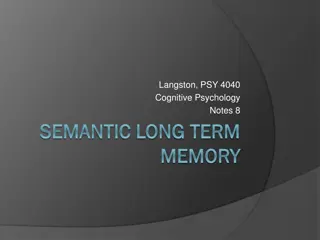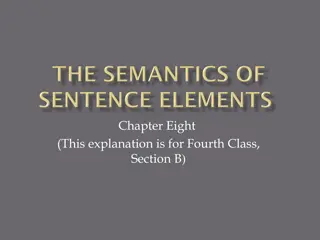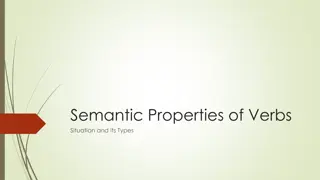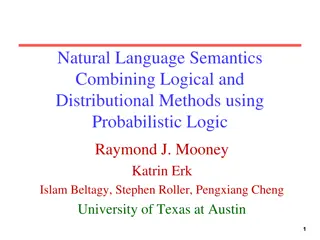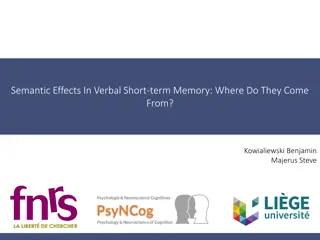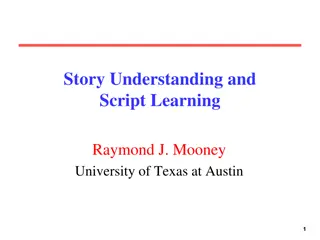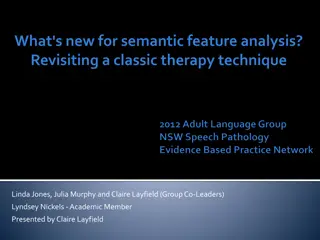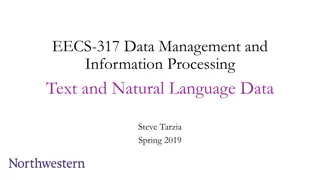Understanding Semantic Concepts in Natural Language Processing
Explore the world of Natural Language Processing (NLP) through images and explanations, covering topics such as text similarity, dimensionality reduction, semantic matching, and the challenges with vector similarity. Dive into the concept space, TOEFL synonyms, SAT analogies, and the importance of reducing dimensionality in processing language data.
Uploaded on Sep 26, 2024 | 0 Views
Download Presentation

Please find below an Image/Link to download the presentation.
The content on the website is provided AS IS for your information and personal use only. It may not be sold, licensed, or shared on other websites without obtaining consent from the author. Download presentation by click this link. If you encounter any issues during the download, it is possible that the publisher has removed the file from their server.
E N D
Presentation Transcript
Text Similarity Dimensionality Reduction
Issues with Vector Similarity Polysemy (sim < cos) bar, bank, jaguar, hot Synonymy (sim > cos) building/edifice, large/big, spicy/hot Relatedness (people are really good at figuring this) doctor/patient/nurse/treatment
Semantic Matching Query = natural language processing Document 1 = linguistics semantics viterbi learning Document 2 = welcome to new haven Which one should we rank higher? Query vocabulary & doc vocabulary mismatch! If only we can represent documents/queries as concepts! That s where dimensionality reduction helps
Semantic Concepts election vote president tomato salad NEWS1 4 4 4 0 0 NEWS2 3 3 3 0 0 NEWS3 1 1 1 0 0 NEWS4 5 5 5 0 0 RECIPE1 0 0 0 1 1 RECIPE2 0 0 0 4 4 RECIPE3 0 0 0 1 1
Semantic Concepts election vote president tomato salad NEWS1 4 4 4 0 0 NEWS2 3 3 3 0 0 NEWS3 1 1 1 0 0 NEWS4 5 5 5 0 0 RECIPE1 0 0 0 1 1 RECIPE2 0 0 0 4 4 RECIPE3 0 0 0 1 1
Concept Space = Dimension Reduction Number of concepts (K) is smaller than the number of words (N) or number of documents (M). If we represent a document as a N-dimensional vector; and the corpus as an M*N matrix The goal is to reduce the dimensionality from N to K. But how can we do that?
TOEFL Synonyms and SAT Analogies Word similarity vs. analogies Example from Peter Turney
Vectors and Matrices A matrix is an m x n table of objects (in our case, numbers) Each row (or column) is a vector. Matrices of compatible dimensions can be multiplied together. What is the result of the multiplication below? 1 2 4 2 5 7 4 9 14 2 1 = 1
Answer to the Quiz 1 2 + 2 1 + 4 ( 1) 2 2 + 5 1 + 7 ( 1) 4 2 + 9 1 + 14 ( 1) 1 2 4 2 5 9 4 7 14 0 2 3 2 1 = = 1
Eigenvectors and Eigenvalues An eigenvector is an implicit direction for a matrix A v A = v v (the eigenvector) is non-zero (the eigenvalue) can be any complex number, in principle. Computing eigenvalues: I A = det( ) 0
Eigenvectors and Eigenvalues 2 Example: 1 3 1 3 = = A A I 2 0 det (A- I) = (-1- )*(- )-3*2=0 Then: + 2-6=0; 1=2; 2=-3 For = 3 3 v 1 = 0 2 2 v 2 Solutions: v1=v2
Matrix decomposition If is a square matrix, it can be decomposed into U U-1, where U = matrix of eigenvectors = diagonal matrix of eigenvalues U = U U-1 U = = U U-1
Example 2 1 = = = , , 1 3 S 1 2 1 2 1 1 = U 1 1 / 1 / 1 2 / 1 2 / 1 = 1 U 2 2 / 1 / 1 1 1 1 0 2 / 1 2 / 1 = = 1 S U U 1 1 0 3 2 2
SVD: Singular Value Decomposition A=U VT U is the matrix of orthogonal eigenvectors of AAT V is the matrix of orthogonal eigenvectors of ATA (co-variance matrix) The components of are the eigenvalues of ATA Properties This decomposition exists for all matrices and is unique U, V are column orthonormal UT U = I; VT V = I is diagonal and sorted by absolute value of the singular values (large to small) Each column (row) of corresponds to a principal component If A has 5 columns and 3 rows, then U will be 5x5 and V will be 3x3
Example (Berry and Browne) T1: baby T2: child T3: guide T4: health T5: home T6: infant T7: proofing T8: safety T9: toddler D1: infant & toddler first aid D2: babies & children s room (for your home) D3: child safety at home D4: your baby s health and safety: from infant to toddler D5: baby proofing basics D6: your guide to easy rust proofing D7: beanie babies collector s guide
Example D1: T6, T9 D2: T1, T2 D3: T2, T5, T8 D4: T1, T4, T6, T8, T9 D5: T1, T7 D6: T3, T7 D7: T1, T3
Example T1 D1 T2 D1: T6, T9 D2: T1, T2 D3: T2, T5, T8 D4: T1, T4, T6, T8, T9 D5: T1, T7 D6: T3, T7 D7: T1, T3 D2 T3 D3 T4 D4 T5 D5 T6 D6 T7 D7 T8 T9
Document-Term Matrix raw normalized 0 1 0 1 1 0 1 0 . 0 58 0 . 0 45 . 0 71 0 . 0 71 0 1 1 0 0 0 0 0 . 0 58 . 0 58 0 0 0 0 0 0 0 0 0 1 1 0 0 0 0 0 . 0 71 . 0 71 0 0 0 1 0 0 0 0 0 0 . 0 45 0 0 0 = = (n ) A A 0 1 1 0 0 0 0 0 . 0 58 . 0 58 0 0 0 0 1 0 0 1 0 0 0 . 0 71 0 0 . 0 45 0 0 0 0 0 0 0 1 1 0 0 0 0 0 . 0 71 . 0 71 0 0 0 1 1 0 0 0 0 0 . 0 58 . 0 45 0 0 0 1 0 0 1 0 0 0 . 0 71 0 0 . 0 45 0 0 0
Dimensionality Reduction Low rank matrix approximation A[m*n] = U[m*m] m*n VT n*n is a diagonal matrix of eigenvalues If we only keep the largest r eigenvalues A U[m*r] r*r VT n*r
T1 -1.10-0.41 -0.56 -0.18 -0.41 -0.30 -0.56 -0.33-0.30 -0.12 0.38 -0.57 0.18 0.38 0.47 -0.57 T2 T3 T4 T5 T6 T7 T8 T9 D1 -0.26 -0.71 -0.42 -0.62 -0.74 -0.50 -0.74 0.53 0.29 0.54 0.51 -0.38 -0.64 -0.38 D2 D3 D4 D5 D6 D7 0.42 0.47 0.6 0.4 0.2 0 -1.2 Y -1 -0.8 -0.6 -0.4 -0.2 0 0.2 0.4 0.6 0.8 1 1.2 -0.2 D7 -0.4 T3,T7 D6 -0.6 -0.8 X
T1 -1.10-0.41 -0.56 -0.18 -0.41 -0.30 -0.56 -0.33-0.30 -0.12 0.38 -0.57 0.18 0.38 0.47 -0.57 T2 T3 T4 T5 T6 T7 T8 T9 D1 -0.26 -0.71 -0.42 -0.62 -0.74 -0.50 -0.74 0.53 0.29 0.54 0.51 -0.38 -0.64 -0.38 D2 D3 D4 D5 D6 D7 0.42 0.47 0.6 0.4 0.2 0 -1.2 Y -1 -0.8 -0.6 -0.4 -0.2 0 0.2 0.4 0.6 0.8 1 1.2 T1 -0.2 D7 -0.4 T3,T7 D6 -0.6 -0.8 X
Semantic Concepts election vote president tomato salad NEWS1 4 4 4 0 0 NEWS2 3 3 3 0 0 NEWS3 1 1 1 0 0 NEWS4 5 5 5 0 0 RECIPE1 0 0 0 1 1 RECIPE2 0 0 0 4 4 RECIPE3 0 0 0 1 1
Semantic Concepts election vote president tomato salad NEWS1 4 4 4 0 0 NEWS2 3 3 3 0 0 NEWS3 1 1 1 0 0 NEWS4 5 5 5 0 0 RECIPE1 0 0 0 1 1 RECIPE2 0 0 0 4 4 RECIPE3 0 0 0 1 1
Quiz Let A be a document x term matrix. What is A*A ? What about A *A?
Interpretation of SVD Best direction to project on The principal eigenvector is the dimension that explains most of the variance Finding hidden concepts Mapping documents, terms to a lower-dimensional space Turning the matrix into block-diagonal form (same as finding bi-partite cores) In the NLP/IR literature, SVD is called LSA (LSI) Latent Semantic Analysis (Indexing) Keep as many dimensions as necessary to explain 80-90% of the data (energy) In practice, use 300 dimensions or so
fMRI example fMRI functional MRI (magnetic resonance imaging) Used to measure activity in different parts of the brain when exposed to various stimuli Factor analysis Paper Just, M. A., Cherkassky, V. L., Aryal, S., & Mitchell, T. M. (2010). A neurosemantic theory of concrete noun representation based on the underlying brain codes. PLoS ONE, 5, e8622
External pointers http://lsa.colorado.edu http://www.cs.utk.edu/~lsi
Example of LSI = U VT A retrieval CS-concept MD-concept brainlung datainf Strength of CS-concept 0.18 0 0.36 0 0.18 0 0.90 0 0 0 0 1 1 2 2 1 1 5 5 0 0 0 0 0 0 1 2 1 5 0 0 0 0 0 0 0 2 3 1 0 0 0 0 2 3 1 Dim. Reduction CS 9.64 0 0 x x = 5.29 0.53 0.80 0.27 MD 0.58 0.58 0.58 0 0 0 Term rep of concept 0 0 0.71 0.71 [Example modified from Christos Faloutsos]
Mapping Queries and Docs to the Same Space qTconcept = qT V dTconcept = dT V CS-concept Similarity with CS-concept datainf.retrieval 0.58 0 0.58 0 0.58 0 0 0 brainlung 0.58 0 = 1 0 0 0 0 qT= 0.71 0.71 dT= 0 1 1 0 0 1.16 0 [Example modified from Christos Faloutsos]




